Furnaces technology. First part: Basic concepts
Today I want to share important information of furnaces in the industrial area, considering furnace technology as a fundamental knowledge for metallurgy and other areas of everyday materials, which have behind their operation a series of studies that allow a better quality and use thereof. I raise in this first part the classification, use and its structure, I hope you like it and it is useful.
Oven: An oven is a device that generates heat and that keeps it inside a closed compartment. It is used both in the kitchen for cooking, heating or drying food, and in industry. The heat energy used to feed a furnace can be obtained directly by combustion (wood, gas or other fuel), radiation (solar light), or indirectly by means of electricity (electric furnace).
Industrial furnaces:
Industrial furnaces are the equipment or devices used in industry, in which materials and parts or elements placed inside are heated above room temperature. The object of this heating can be very varied, for example:
- To reach the necessary temperature so that the necessary chemical reactions take place to obtain a certain product.
- Changes of state (Fusion of metals and vaporization).
- Soften for a subsequent forming operation.
- Treat thermally to impart certain properties.
- Cover the pieces with other elements, an operation that is frequently facilitated by operating at a temperature higher than that of the environment (Vitrified ceramic products).
Main parts of the kilns:
The main part of each furnace is the work zone, where the predetermined technological process is carried out. In most cases, this area is separated from the environment by the vault, the walls and the floor, constructed of refractory and heat insulating materials, at its base have the foundations, built of common materials.
Classification:
Thus, depending on the type of effect that the oven produces on the product, you can have:
- Furnaces to produce physical effects in the product, which in turn can be divided into:
- Heating furnaces
- Melting furnaces
- Furnaces to produce chemical effects in the product (Reduction without fusion, reducing fusions, sintering, roasting, calcination, reductive volatilization, volatilization, metallotherms, etc.)
It should be noted that the previous definition, apparently clear, is not so much in practice, since it is common to use other terms such as:
1.- Stoves, for ovens operating at low temperature but without defining this, normally up to 500-600 ° C.
Cooper heaters or recovers are used for air preheaters in blast furnaces that operate at high temperatures.
2.- Dryers (also called, when done by raising the temperature, drying stoves). The drying temperature can be high and adopt a construction technique similar to that of ovens.
3.- Coke batteries are the series of cell-type ovens used in the production of coke.
4.- Anchoring coffers in the glass industry.
5.- Incinerators, equipment for combustion and waste disposal. (Lesson 1. Uniovi)
Another classification would be: 1) Flame or fuel furnaces and 2) Electric furnaces.
Flame or Fuel Ovens:
There are solid fuel such as coal or coke such as cupolas, blast furnaces and Reverbero furnace that work with long-flame coal, but you can also use coal dust, oil, coke gas or methane. Among them could enter the converters that use the dissolved carbon in the pig iron of the blast furnace or the iron foundry from the cupola. Those of liquid fuel such as diesel, Kerosene, Orimulsion (furnaces in thermoelectric plants to heat steam) and gaseous as would be some melting furnaces for melting metals, kilns for ceramics or heaters in general.
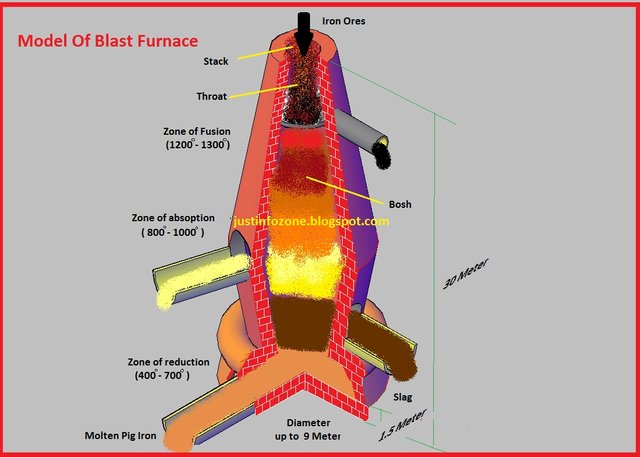
Source
FLAME OVENS are divided according to their form in:
- VERTICAL OR CUBA OVENS (Cubilote)
- BALSA OVENS (Rectangular-shaped ovens normally for glass)
- ROTARY OVENS. Also called carousel ovens.
ELECTRIC FURNACES
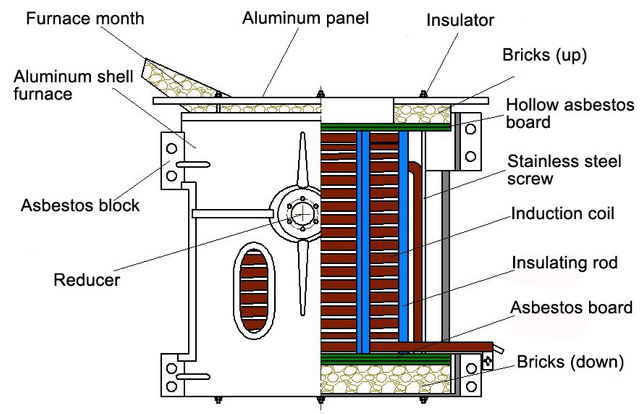
Source
Some of the advantages of electric heating that are indicated below are evident:
1.- Absence of combustion fumes.
2.- Better working conditions around the furnace and environmental conditions on the outside.
3.- Greater security of the personnel.
4.- Possibility of keeping the ovens unattended outside working hours due to elimination of the
danger of explosions.
5.-Simpler use of ceramic fibers as oven insulation.
6.- Great elasticity of operation and simple automation of the ovens.
It has been frequent the installation of the various kilns of an industrial plant in its own premises
called department of furnaces or of thermal treatments, with the cost that this supposes by the transport of the pieces from the mechanized and until the line of setting or later process. The electric ovens allow to install the ovens inside the production lines, since perfectly acceptable environmental conditions are achieved.
In the flame furnaces reference is made to the type of enclosure, which can also occur in furnaces electric.
Gas furnaces periodic and continuous.
Gas oven Advances in the use of natural gas as a fuel have allowed gas ovens to be a viable option in the alternatives offered by their use, showing themselves to be very effective, both due to the reduction of cooking times for raw materials, and the reduction of emissions to the environment. The regulation of the atmosphere inside the furnace can be controlled by varying the injection of the gas and air mixture, so they are very useful for making reductions. Another advantage worth mentioning is that high temperatures are reached in a shorter time. The concept of newspaper refers to the fact that the load is made in intervals and continuous is when the load enters and leaves the different zones without interruption.
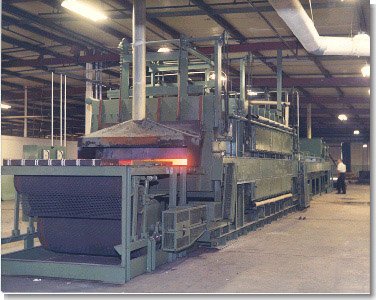
Source
Roller furnaces
In roller furnaces, these produce a movement, of continuous and smooth translation. They can be prepared to cook with refractory plates or without them. The tunnel kiln on the rollers of ceramic pieces using refractory plates presents cycles of fast execution and reduced consumption. Thus, the cooking cycles are 2 - 3 hours for vens without plates and 45 - 65 minutes with them.
The rollers can be made of refractory material, mainly sillimanite, or stainless steel Iconel type. The disadvantages are, in the refractory material, the fragility and, in the stainless steel, the curvature of the rollers.
They present the same characteristic zones as tunnel kilns, they are normally free flame and use gaseous fuel, natural gas or LPG. Due to the cooking in free flame, the specific energy consumption is significantly lower than in the muffled furnaces (Muffle furnace refers to a small oven type gas drawer or resistance), being of the order of 2926 KJ / Kg of cooked product for the case of single-firing of pavement and of the order of 2090 KJ / Kg of cooked product in the case of firing of enameled product (double-firing).
Another type of difference between these furnaces is the use of refractory ceramic fiber or refractory brick of low specific heat. Due to thermal inertia, ceramic fiber is more advisable, but due to the attack of various substances on ceramic fiber and especially its deterioration over time, refractory brick seems more interesting.
Its structural characteristics are:
Prefabricated modular structure.
Insulation by special light refractories with microporous structure for the elements in contact with the fire and ceramic fibers for those not exposed to the flame.
Furnace vault in insulating refractory hanging from the roof of the module by means of hooks
stainless steel.
The hearth is made of refractory material whose protective coating is dense refractory plates.
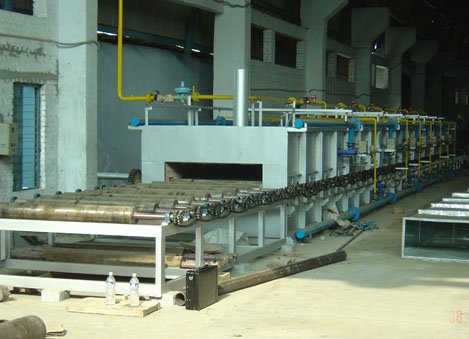
Source
Special ovens:
Under the criterion of special ovens is understood all that oven that owns forms or dimensions or q consumes fuels or reaches temperatures or uses refractories other than conventional ones. (Lex) Among the special ovens we find the following:
- Furnaces for production and laboratory
- Equipment for high temperature applications up to 1850 ° C
- Equipment for use in special atmospheres
References
https://www.slideshare.net/eecfncci/improving-furnaces-ee-20130108-kb
http://katedry.fmmi.vsb.cz/Opory_FMMI_ENG/MMT/Industrial%20Furnaces.pdf
CAPELLO, EDUARDO (2009). Foundry technology. Editorial Gustavo Gili
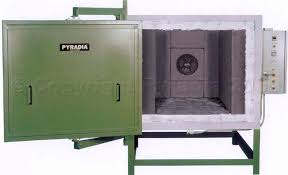.jpg)
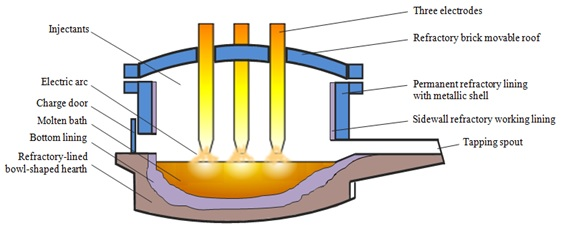
This is a very nicely prepared post. I read your post and it is certain that you care this post. We need to support beautiful posts like yours. I follow you to learn good information. Keep it up!
Luckily you liked it, checking your blog and I also found very good information and I follow you.